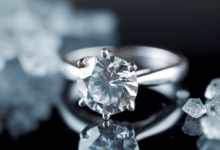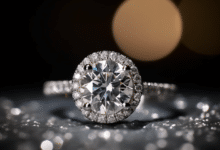The Shocking Truth: 5 Engagement Ring Myths Debunked

When it comes to buying an engagement ring, there’s a lot of misinformation out there. From the “three months’ salary” rule to the myth that diamonds are a girl’s best friend, it’s time to separate fact from fiction. In this article, we’ll debunk five common engagement ring myths and reveal the shocking truths that every savvy shopper needs to know.
1. The “Three Months’ Salary” Rule
One of the most pervasive engagement ring myths is the notion that you should spend three months’ salary on a diamond ring. This outdated rule was popularized by an incredibly successful marketing campaign by De Beers in the 1930s. However, according to industry experts, there is no universal rule for how much you should spend on an engagement ring.
- “The ‘three months’ salary’ rule is an arbitrary and outdated concept that has no basis in reality,” says Jennifer Gandia, co-owner of Greenwich St. Jewelers in New York City. “The amount you spend on an engagement ring should be based on your personal budget and preferences, not a marketing slogan.”
- Emma Schepps, sales and marketing director at Schepps Diamond Jewelers, agrees: “There is no one-size-fits-all rule for how much to spend on an engagement ring. It’s a deeply personal decision that should be based on your unique financial situation and what you and your partner value.”
2. Bigger Is Always Better
Another common myth is that bigger is always better when it comes to diamond size. While a larger diamond may seem more impressive at first glance, it’s important to consider other factors such as cut quality, color, and clarity.
- “A well-proportioned, beautifully cut diamond will have more sparkle and fire than a larger diamond with a poor cut,” explains Jason Arasheben, CEO of Jason Beverly Hills. “Size isn’t everything; focus on overall beauty and quality.”
- Amanda Gizzi, director of public relations at Jewelers of America, adds, “It’s better to have a slightly smaller diamond with excellent color and clarity than a larger diamond with visible flaws or an unappealing tint.”
3. Diamonds Are a Girl’s Best Friend
While diamonds have long been considered the ultimate symbol of love and commitment, this myth perpetuates the idea that all women want and expect a diamond engagement ring. In reality, many couples are embracing alternative gemstones or opting for unique, non-traditional designs.
- “There’s a growing trend towards alternative gemstones like sapphires, emeralds, and rubies,” says Kristen Lawler-Trustey, director of public relations at Forevermark. “These colorful gems allow for more personalization and can be just as meaningful as a diamond.”
- Zaven Ghanimian, CEO of Simon G. Jewelry, agrees: “More and more couples are choosing unique, custom-designed rings that reflect their individual styles and personalities. The options are endless, from mixed metal bands to nature-inspired motifs.”
4. Mined Diamonds Are Superior
While mined diamonds have been the traditional choice for engagement rings, the myth that they are superior to lab-grown diamonds is quickly being debunked. In fact, lab-grown diamonds are chemically, physically, and optically identical to their natural counterparts.
- “Lab-grown diamonds are a ethical and environmentally-friendly alternative to mined diamonds,” says Vaken Yepremyan, CEO of Leo Diamond. “They offer the same fire, brilliance, and durability as mined diamonds but at a fraction of the cost.”
- Sarah Mehta, director of sustainability at the Diamond Producers Association, adds, “Both mined and lab-grown diamonds have their merits. It ultimately comes down to personal preference and budget.”
5. Resale Value Is a Concern
One of the biggest myths surrounding engagement rings is that they hold significant resale value. While it’s true that diamonds can be resold or traded in, the resale value is often much lower than the original purchase price.
- “An engagement ring is a symbol of love and commitment, not an investment,” says Amanda Gizzi of Jewelers of America. “Don’t buy a ring with the expectation of recouping the full cost down the line.”
- Jennifer Gandia of Greenwich St. Jewelers adds, “Focus on finding a ring that you or your partner will cherish for a lifetime, rather than worrying about resale value.”
By debunking these common engagement ring myths, you can approach the ring-buying process with a more informed and realistic mindset. Remember, the most important thing is finding a ring that symbolizes your love and commitment, not adhering to outdated rules or unrealistic expectations.












